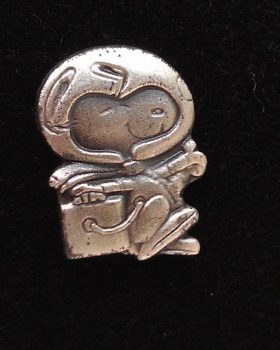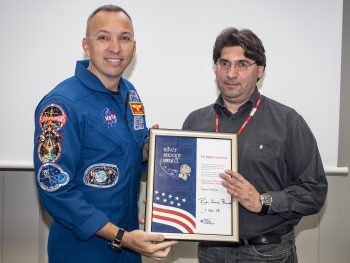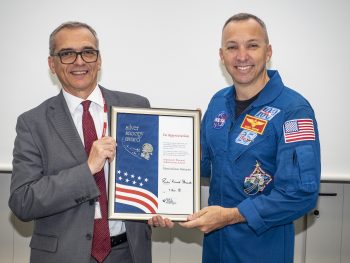The European Service Module (ESM) team has much to celebrate these days. Not only is the unit now at Kennedy Space Center for integration and testing, a major milestone for the team that has worked diligently over the past years, but two team members have been awarded with Silver Snoopy awards to boot.
The Silver Snoopy award was created by NASA during the Apollo years to recognise outstanding achievements to human spaceflight safety and mission success among its staff and contractors. Created in close collaboration with Charles Schulz, the creator of the Peanuts comic strip, the award is comprised of a space-flown sterling silver “Snoopy the Astronaut” pin and commendation letter presented to awardees by a NASA astronaut.
NASA astronaut Randy Bresnik, who recently flew as part of Expedition 52/53 with ESA astronaut Paolo Nespoli, presented the award to Enrico Parisio and Massimiliano Bottacini at the Orion European Service Module Pre-Shipment Review held in Bremen, Germany, on 1 November. Their Silver Snoopy pins were flown on the first demonstration mission of the Orion programme called Exploration Flight Test-1. This is only the second time ESA employees have been awarded Silver Snoopys, remarkable given that only 1% of NASA’s workforce have received the award since 1968!
The award caught Product Assurance Engineer and Configuration Management Lead Enrico Parisio off guard, though “I always felt appreciation around me for my work,” says Enrico.
Enrico’s work, in a nutshell, is to ensure that industries design and build quality-assured hardware that meet all requirements defined by NASA and ESA for the Orion spacecraft. This means following the technical and design blueprints for the European Service Module from its development, to assembly and integration and finally to testing, making changes, recommendations and rejections (if needed) along the way.
Having worked on Node-2 and Node-3 components for the International Space Station and the Automated Transfer Vehicle (ATV) programmes, Enrico was no stranger to a multinational spaceflight programme. However, “ESM is quite a challenging project,” Enrico says.
The production schedule for the European Service Module followed a less traditional workflow due to scheduling constraints. The team had to juggle many aspects of the engineering and qualification processes at the same time rather than in succession. Thanks to ATV’s tried and true legacy, the team were able to take some shortcuts and learned to prioritise problems based on needs and risks.
But what greatly helped to keep the ESM programme on schedule was Enrico’s proposal to put an incremental documentation review in place and sign off on components as they were accepted rather than wait until the entire European Service Module’s system delivery. This took more than two years but allowed for a timely delivered ESM to Kennedy Space Center.
This intuition and insight comes from over 30 years in the space industry. Armed with just a secondary diploma at the age of 19, Enrico’s hard work and determination over the years landed him on the team that is working to return humanity to the Moon. He has learned many lessons, namely to always keep motivated. He advises youth to “try to find motivation for those tasks that you may not prefer to do, to guarantee that you always do a good job.”
Enrico has since read up on the history of the Silver Snoopy award and is immensely proud to have received it on behalf of his work and the entire ESM team. “My daughter instagrammed it, so I know it’s a bit of a big deal,” he jokes.
From nuclear engineering to lunar spaceflight
Like Enrico, Chief Engineer Massimiliano Bottacini for the European Service Module sees his Silver Snoopy award as a recognition not only of his professional life, all spent in Human Spaceflight programmes, but also of the entire ESM team.
Trained in nuclear engineering from the Polytechnic University of Turin, Massimiliano worked in the space industry starting in 1986, first as a thermal engineer and soon after in system engineering, designing spacecraft for US customers and ESA.
In 2009 he went from producer to customer, representing ESA from a technical point of view as Chief Engineer. In this role, Massimiliano negotiates technical requirements and ensures that designs presented by industry meet them.
Massimiliano’s industry experience was invaluable to resolving technical and programmatic issues over the years. “ESM is a particular programme,” explains Massimiliano. “It is one piece of a larger system.” It is a complex juggling act to ensure correct interfaces for all Orion functions that are split between ESA and NASA elements.
Understanding the design process meant Massimiliano did not need to wait for industry to propose solutions to technical and engineering challenges that, as representative of ESA, he knew would also satisfy NASA’s requirements.
It was nevertheless a challenge. “It is natural to feel some worry when confronted with issues. But we solved problems and that relief is always motivating.”
Massimiliano was 11 years old when Apollo 11 landed on the Moon, an inspiring moment for him. But it wasn’t the astronauts that captured his imagination. It was the spacecraft and its system-oriented engineering. “I like that someone is landing, but not necessarily me.”
Congratulations to Enrico, Massimiliano, and the entire European Service Module team for their hard work!




 Automated Transfer Vehicle page
Automated Transfer Vehicle page ATV blog archive
ATV blog archive
Discussion: one comment
Awesome resources. Planeta Neperiano has been created by three computer engineering students who at the end of their studies decided to make one of the many projects they thought about during their studies come true. Neperian Planet is one of these projects, which due to different reasons was being delayed again and again.